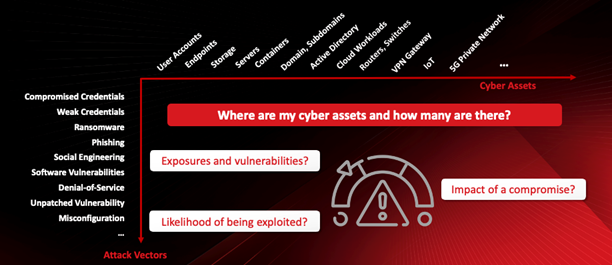
In the ever-evolving landscape of cybersecurity, organizations like yours are continually grappling with an array of threats, each more sophisticated than the last. The traditional methods of cybersecurity, which often involve a blanket approach of applying uniform security measures across all systems, are proving increasingly ineffective against these dynamic threats.
Re-evaluating the standard way of protecting your assets starts with asking these questions:
- How can your organization effectively identify and secure its IT assets in this ever-changing environment?
- Is there a way to quantify your cyber risk in a manner that aligns with business strategies?
- How can you communicate these risks to those at the helm, ensuring a unified approach towards digital defense and company risk reduction?
This situation calls for a paradigm shift towards a more strategic and tailored approach. Risk-based cybersecurity.
In order to understand this approach, it’s important to identify its key components, these include:
Risk-based asset identification and classification. Many organizations like yours struggle with visibility across their entire attack surface. This leads to challenges in securing your assets and data and ends up increasing vulnerabilities to cyberattacks.
Risk-based threat assessment. Understanding the current threat landscape to identify potential threats is vital. This involves analyzing threats with a focus on those that pose the highest risk to your organization's critical assets.
Risk-based vulnerability analysis. Regular scanning and testing are essential, with a focus on vulnerabilities that present the greatest risk.
Risk prioritization. This is crucial for making informed decisions and understanding the impact of investments and cybersecurity activities.
Implementation of risk-based targeted controls. Emphasizing the implementation of zero-trust architectures is crucial for effective risk prioritization, albeit complex.
Continuous monitoring and improvement. Centralizing visibility across your attack surface is key for continuous risk management and adapting to the evolving threat landscape.
Transitioning from reactive to proactive cybersecurity
Adopting a risk-based approach in cybersecurity is a pivotal step towards shifting from a reactive to a proactive cybersecurity posture. You can move toward this by:
Anticipating threats. Risk-based cybersecurity involves anticipating potential threats and vulnerabilities, rather than merely responding to incidents after they occur.
Allocating strategic resources. By prioritizing threats based on their risk levels, you can strategically allocate resources to where they are needed most, preventing breaches before they happen.
Tailoring security measures. Implementing controls that are specifically designed to protect your most critical assets against the most likely threats ensures a targeted and effective defense strategy.
Enhancing situational awareness. Continuous monitoring and risk assessments provide real-time insights into the threat landscape, allowing your organization to adapt and respond proactively to emerging threats.
Cultivating a proactive culture: Shifting to a risk-based approach necessitates a cultural change within your organization, fostering a mindset that is always looking ahead and preparing for potential cybersecurity challenges.
Implementing a risk-based cybersecurity strategy with attack surface risk management (ASRM)
ASRM is the continuous discovery, assessment, and mitigation of your organization’s IT ecosystem. This differs from asset discovery and monitoring in that ASRM evaluates security gaps from the attacker’s perspective, including risk across people, processes, and technology.

The right ASRM solution can operationalize your cyber risk management, which requires continuous command across the three phases of your attack surface risk lifecycle: discovery, assessment, and mitigation. Let’s take a deeper look.
Cyber asset discovery
First, you need total visibility to discover and continuously monitor known, unknown, internal, and internet-facing (external) assets. Siloed point products across vectors like endpoints, users, devices, cloud, and networks limit overstretched security teams from taking stock or performing manual audits. Also consider that new projects with open-source dependencies and user/device accounts are spun up instantly, meaning you need to be able to see your entire ecosystem as it changes, not after.
The goal is to gain visibility to answer questions such as:
- What is my attack surface?
- How well can I see what assets are in my environment?
- How many, what types, and what attributes are associated with these assets?
- What are my high-value assets?
- How is my attack surface changing?
Risk assessment
Being able to see your entire ecosystem as it changes is the first step. Next, your security teams need to assess and prioritize any weaknesses or vulnerabilities. This doesn’t just apply to systems but user types as well. For example, executive-level employees are the most common targets for business email compromise (BEC).
In addition, we’ve seen an uptick in campaigns targeting software supply chains and DevOps pipelines, meaning processes also need to be evaluated for any security gaps.
Ideally, this risk information will be contextualized for greater understanding so you can answer the following questions:
- Can I quantify my risk? What is my overall risk score?
- Is my risk score increasing or decreasing over time?
- How does it compare to peers in the industry?
- Where do I see the most significant security risks?
- What risk factors need immediate attention?
Risk mitigation
While discovering and assessing risks across your digital attack surface is important, it’s also critical to receive actionable prioritized mitigation recommendations to lower risk exposure. Virtual patching, changing configuration options on a prevention control, and controlling user access parameters are just a few examples.
Furthermore, mitigation should be automated wherever possible to increase efficiency and reduce the chance of a successful attack or breach.
With the skills shortage introducing very real challenges to managing your attack surface, the opportunity to create a common framework and a single pane of glass is paramount to effective cyber risk management. Enter XDR and zero-trust strategies.
The importance of XDR
Investments in XDR means you have data, analytics, integrations, and technology in place that could serve as a foundation for serving other use cases and providing insight and operational value beyond the realm of detection and response.
More proactive risk prioritization and mitigation benefits your SOC by reducing overall exposure and the scope of a security incident. Conversely, detection data collected by XDR provides you with valuable insight into attack surface threat activity and shows you how current defenses are coping. In turn, this can inform risk assessments and response recommendations.
Learn more in The Race to Support Overwhelmed Security Teams with XDR and SOC Modernization
Supporting zero-trust strategies
Proactive cyber risk management depends on operationalizing elements of a zero-trust strategy. Zero trust is an extension of the principle of least privilege, wherein any connection—whether it’s from within the network or not—should be considered untrustworthy. This is crucial in your modern hyper-connected, remote work environment, which has increased the number of different entry points or connections into the enterprise.
As always, this needs to be an ongoing process that constantly evaluates identity, user, and device activity, as well as application, vulnerability, and device configuration. The demand for continuous assessment has led to many SOCs shifting toward the secure access service edge (SASE) architecture, which combines discrete capabilities such as cloud application security broker (CASB), secure web gateway (SWG), and zero trust network access (ZTNA) for more granular control across your network.
Tying it all together, XDR alongside risk insight and mitigation that is aligned with zero trust, can further enhance your security. XDR lets you establish a solid foundation for verifying and establishing trust. And since it continuously collects and correlates data, it lets you fulfill the continuous assessment pillar of the zero-trust strategy.
A new approach to digital defense
The adoption of a risk-based approach in cybersecurity is not just a tactical shift, but a strategic imperative in the face of evolving cyber threats. ASRM uses this framework to help you effectively protect your most valuable assets and align your cybersecurity efforts with your business strategy. It not only allows you to guard against current threats but also prepares you for future challenges, ensuring you’re always equipped with a responsive and robust cybersecurity posture.
Trend Vision One™ is a modern, AI-powered cybersecurity platform designed to leverage full lifecycle ASRM solutions, XDR, global threat intelligence, AI/ML technology, and zero-trust principles. This combination bridges comprehensive threat prediction, prevention, detection, and response capabilities for superior protection against cyber threats.


